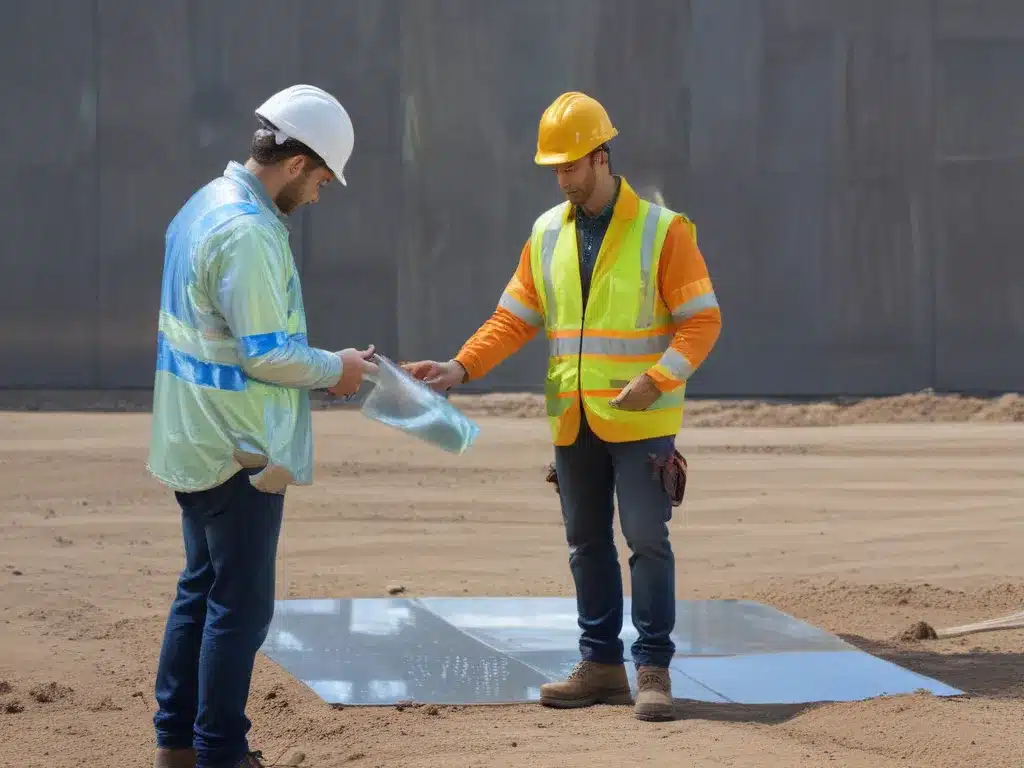
Revolutionizing Construction Site Safety with Cutting-Edge Holographic Technology
Imagine a construction site where hard hats and safety vests aren’t just physical protective gear, but also serve as a portal to an immersive, holographic training experience. That’s the future I’m excited to share with you today – a future where worker safety is elevated to new heights through the power of holographic technology.
As the safety manager at Atchison Construction, I’ve seen my fair share of on-site incidents and near-misses. It’s a constant battle to keep our crews informed, engaged, and vigilant when it comes to hazard identification and risk mitigation. But all that changed when we decided to incorporate holographic safety training into our workflow.
Let me take you on a journey and show you how this innovative approach is transforming the way we approach construction site safety.
Bridging the Gap Between Theory and Practice
One of the biggest challenges we faced in the past was conveying the importance of safety protocols to our workers. Sure, we had the mandatory safety briefings and training sessions, but let’s be honest – they often felt like a box-ticking exercise. The workers would nod along, retain a few key points, and then quickly revert to their old habits once they were back on the job site.
That all changed when we introduced holographic safety training. Imagine a scenario where your workers can see, feel, and interact with simulated hazards in real-time, right before their eyes. Suddenly, those dry safety procedures come to life, and the importance of following them becomes crystal clear.
I’ll never forget the first time we ran a holographic training session. We set up a mock-up of a tricky scaffolding scenario, complete with virtual tools, materials, and potential hazards. As the workers donned their augmented reality (AR) headsets, the job site materialized around them, and they were immersed in a lifelike simulation.
They could see the potential falling risks, the proper way to secure the scaffolding, and the consequences of cutting corners. And the best part? They could make mistakes in this virtual environment without any real-world consequences. It was a game-changer.
Increased Engagement and Retention
One of the most remarkable aspects of holographic safety training is the level of engagement and retention it fosters among our workers. Gone are the days of passive, disinterested participants. Instead, we have crews who are actively involved, asking questions, and experimenting with different safety scenarios.
I remember one worker, let’s call him Mike, who was initially skeptical about the whole holographic training idea. He’d been on the job site for years and thought he had safety down to a science. But when he experienced the simulation, his eyes widened, and he suddenly saw the job site in a completely new light.
“I had no idea how much risk was involved in that particular scaffolding setup,” Mike told me afterwards. “The hologram made it so real, and I could see exactly where I was going wrong. Now, I’m going to be extra vigilant about checking those safety lines before I even set foot on the platform.”
Moments like these are what make the investment in holographic technology so worthwhile. We’re not just imparting knowledge; we’re creating a deeper understanding and a genuine commitment to safety among our workers.
Customized Training for Diverse Needs
One of the standout features of our holographic safety training is its versatility. We’re able to tailor the simulations to the specific needs and challenges of each job site, ensuring that our workers are prepared for the unique hazards they may encounter.
Take, for example, the specialized training we developed for our high-rise construction team. Working at dizzying heights requires a whole different set of safety considerations, and the traditional safety briefings just didn’t cut it. But with holographic training, we were able to recreate the unique hazards of working on the upper floors of a skyscraper, from managing heavy loads to navigating narrow walkways.
The results were astounding. Our high-rise crew reported a significant increase in their confidence and ability to identify and mitigate risks, and we saw a corresponding drop in incidents and near-misses on those job sites.
But it’s not just the high-risk, high-profile projects that benefit from this technology. We’ve also used holographic training to address more mundane, yet still crucial, safety concerns, such as proper lifting techniques, electrical safety, and hazardous material handling.
By tailoring the simulations to the specific needs of each crew, we’re able to ensure that our workers are truly prepared for the challenges they’ll face on the job site, no matter the task at hand.
Embracing the Future of Safety
As I look to the future, I can’t help but feel excited about the endless possibilities of holographic safety training. This technology is just the beginning of a revolution in the way we approach construction site safety.
Imagine a world where workers can seamlessly transition between physical and virtual job sites, practicing complex maneuvers and responding to emergency scenarios in real-time. Or a future where the construction hard hat isn’t just a symbol of safety, but a gateway to a personalized, AI-powered training program that adapts to each worker’s needs and learning style.
The possibilities are truly limitless, and I’m proud to be at the forefront of this technological revolution. By embracing holographic safety training, we’re not just protecting our workers – we’re shaping the future of the construction industry, one job site at a time.
So, if you’re still relying on the traditional safety briefings and training sessions, I urge you to consider the power of holographic technology. It’s a game-changer, and it just might be the key to ensuring that every worker on your job site returns home safely at the end of the day.
Unlocking the Full Potential of Holographic Safety Training
As the safety manager at Atchison Construction, I’ve seen firsthand the transformative impact of holographic safety training on our job sites. But to truly unlock the full potential of this cutting-edge technology, we’ve had to overcome a few challenges along the way.
Overcoming Initial Skepticism
When we first introduced holographic safety training to our crews, I won’t lie – there was a fair amount of skepticism and resistance. Some of our more seasoned workers were convinced that the “old-fashioned” safety protocols were good enough, and they were hesitant to embrace this new, seemingly complicated technology.
It took a lot of patience and persistence on our part to break down those barriers. We started by highlighting the real-world benefits of holographic training, such as the increased engagement and retention we witnessed. We also made sure to provide thorough training and support, ensuring that every worker felt comfortable and confident using the AR headsets and navigating the simulations.
Slowly but surely, the skepticism began to melt away, and our crews started to see the true value of this innovative approach to safety. And once they experienced the holographic simulations for themselves, there was no going back. They were hooked, and the demand for more holographic training only continued to grow.
Integrating with Existing Safety Protocols
Another challenge we faced was figuring out how to seamlessly integrate holographic safety training with our existing safety protocols and procedures. After all, we couldn’t simply abandon the tried-and-true methods that had served us well for years – we needed to find a way to marry the old and the new.
Through careful planning and collaboration with our safety team, we were able to develop a comprehensive approach that leveraged the best of both worlds. The holographic simulations became the foundation for our safety training program, providing an immersive and engaging way to teach and reinforce key concepts.
But we didn’t stop there. We also incorporated elements of our traditional safety briefings, ensuring that our workers were still receiving the essential information and reminders they needed to stay safe on the job site. This hybrid approach allowed us to capitalize on the strengths of holographic training while maintaining the familiarity and reliability of our existing safety protocols.
The result? A more robust, well-rounded safety program that keeps our workers informed, engaged, and, most importantly, safe.
Investing in the Right Technology
Of course, the success of our holographic safety training program didn’t come without a significant investment in the right technology. From the AR headsets and motion-tracking sensors to the custom software and hardware required to build our simulations, we had to carefully evaluate and select the best solutions for our needs.
It was a daunting task, to be sure. With so many options on the market, it was crucial that we took the time to research, test, and compare different systems to ensure we were making the right choice. We consulted with industry experts, attended trade shows, and even invited vendors to demonstrate their products on-site.
In the end, we settled on a robust, enterprise-grade holographic platform that seamlessly integrated with our existing safety management systems. The investment was substantial, but the payoff has been immeasurable. Our workers are safer, our incident rates have plummeted, and our clients have been impressed by our commitment to cutting-edge safety practices.
Continuous Improvement and Adaptation
As with any new technology, the journey of holographic safety training at Atchison Construction has been an ongoing process of continuous improvement and adaptation. We’re constantly evaluating the effectiveness of our simulations, gathering feedback from our workers, and exploring ways to enhance the holographic experience.
For example, we recently partnered with a leading virtual reality (VR) research lab to explore the use of haptic feedback – the ability to physically “feel” the simulated objects and environments. The initial results have been nothing short of incredible, as our workers report an even deeper sense of immersion and realism in the holographic training scenarios.
We’ve also been exploring ways to leverage artificial intelligence (AI) and machine learning to personalize the holographic training experience for each worker. Imagine a future where the AR headset can detect a worker’s individual learning style and adjust the simulations accordingly, providing tailored feedback and guidance in real-time.
The possibilities are endless, and we’re committed to staying at the forefront of this technological revolution. By continuously innovating and adapting our holographic safety training program, we’re ensuring that our workers are always one step ahead of the curve, equipped with the knowledge and skills they need to navigate the ever-changing job site landscape.
Embracing the Future, One Hologram at a Time
As I look back on our journey with holographic safety training, I can’t help but feel a sense of pride and excitement. We’ve come a long way, overcoming skepticism, integrating new technology, and continuously improving our approach to construction site safety.
But the real reward lies in the tangible results we’ve seen on our job sites. Fewer incidents, increased worker engagement, and a culture of safety that permeates every aspect of our operations. It’s a testament to the power of holographic technology, and a testament to the dedication and commitment of our crews.
So, if you’re a construction company still relying on traditional safety training methods, I urge you to consider the transformative potential of holographic technology. It’s not just a gimmick – it’s a game-changing solution that can truly revolutionize the way we approach worker safety.
Embrace the future, one hologram at a time, and watch as your job sites become safer, more efficient, and more innovative than ever before. The possibilities are endless, and I can’t wait to see what the next chapter holds.
Harnessing the Power of Holographic Technology for Comprehensive Safety Training
As the safety manager at Atchison Construction, I’ve been on the forefront of the construction industry’s shift towards holistic, technology-driven safety solutions. And let me tell you, the impact of holographic safety training on our job sites has been nothing short of remarkable.
Revolutionizing the Training Experience
One of the key advantages of holographic safety training is its ability to create an immersive, engaging learning environment that simply can’t be replicated through traditional methods. Gone are the days of passive, lecture-style safety briefings where workers struggle to stay focused and retain the information.
Instead, our crews don the AR headsets and are transported into a lifelike, 3D simulation of the job site. They can see, touch, and interact with the virtual tools, materials, and potential hazards, gaining a deeper understanding of the risks and the proper safety protocols.
It’s a transformative experience that truly brings the safety training to life. I’ll never forget the first time one of our newer workers, let’s call her Sarah, tried out the holographic simulation. She emerged from the experience with a look of astonishment on her face, exclaiming, “I had no idea how dangerous that particular scaffolding setup was! I’m going to be so much more careful going forward.”
Moments like these are what make the investment in holographic technology so worthwhile. We’re not just imparting knowledge – we’re creating a genuine, lasting commitment to safety among our workers.
Addressing Diverse Training Needs
One of the standout features of our holographic safety training program is its ability to cater to the diverse needs and learning styles of our workers. Each job site presents its own unique set of challenges and hazards, and a one-size-fits-all approach simply doesn’t cut it.
That’s why we’ve developed a comprehensive library of holographic simulations, each tailored to the specific requirements of our various job sites and crew specialties. From high-rise construction to electrical work, our workers can immerse themselves in true-to-life scenarios, honing their skills and preparing for the very real risks they’ll face on the job.
But it’s not just about the physical environment – we also recognize the importance of addressing the psychological and behavioral aspects of safety. That’s why we’ve incorporated elements of situational awareness training, teaching our workers to anticipate and respond to potential hazards before they even occur.
Imagine a holographic simulation where a worker is tasked with navigating a cluttered job site, identifying potential trip and fall hazards, and making split-second decisions to mitigate risks. It’s a powerful learning experience that goes beyond the traditional “do’s and don’ts” of safety training, empowering our crews to think critically and act proactively.
Enhancing Collaboration and Knowledge Sharing
One of the unexpected benefits of our holographic safety training program has been the way it’s fostered a culture of collaboration and knowledge sharing among our workers.
In the past, safety training was often seen as a top-down, one-way street, with managers and safety experts imparting their wisdom to the crews. But with the holographic simulations, we’ve created a dynamic, interactive learning environment where everyone can contribute and learn from one another.
I’ve witnessed workers from different crews coming together to tackle the same holographic scenario, sharing their unique perspectives and strategies. It’s a rich exchange of knowledge and experience that simply wouldn’t be possible in a traditional classroom setting.
Moreover, the holographic platform allows us to easily capture and disseminate best practices and lessons learned across our entire organization. A worker who uncovers a clever solution in one simulation can instantly share it with their colleagues, ensuring that the entire team benefits from their insights.
This collaborative approach to safety training has been a game-changer, fostering a sense of shared responsibility and continuous improvement among our crews. It’s not just about checking the safety box – it’s about empowering our workers to be active participants in the safety process, driving innovation and excellence in everything they do.
Unlocking Data-Driven Insights
But the true power of holographic safety training extends far beyond the immediate training experience. By integrating our holographic platform with advanced data analytics and AI-powered tools, we’re unlocking a wealth of insights that are transforming the way we approach construction site safety.
Imagine a scenario where the holographic simulations can track and analyze every movement, decision, and interaction made by our workers. This data can then be used to identify patterns, detect potential areas of concern, and even predict future incidents before they occur.
It’s a level of visibility and predictive capability that was simply unimaginable just a few years ago. And the best part? We’re using these data-driven insights to continuously refine and optimize our safety training programs, ensuring that our workers are always one step ahead of the curve.
But the benefits of this data-driven approach don’t stop there. By sharing these insights with our clients and industry partners, we’re helping to drive the entire construction industry towards a safer, more efficient future. It’s a collaborative effort that will ultimately save lives and protect the wellbeing of everyone who steps foot on a job site.
Embracing the Future of Construction Safety
As I reflect on the journey we’ve taken with holographic safety training at Atchison Construction, I can’t help but feel a sense of excitement and optimism for the future.
This technology is just the beginning of a revolution in the way we approach construction site safety. Imagine a world where every worker has a personalized, AI-powered safety assistant, constantly monitoring their movements and providing real-time alerts and guidance. Or a future where job sites are entirely digitized, with holographic simulations seamlessly integrated into the physical environment.
The possibilities are truly endless, and I’m proud to be at the forefront of this technological transformation. By embracing the power of holographic technology, we’re not just protecting our workers – we’re shaping the future of the construction industry, one job site at a time.
So, if you’re a construction company looking to elevate your safety standards and stay ahead of the curve, I urge you to consider the transformative potential of holographic safety training. It’s a game-changer, and it just might be the key to ensuring that every worker on your job site returns home safely at the end of the day.





